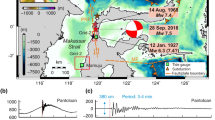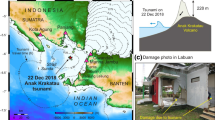Abstract
Tsunami waves severely damaged the densely populated coast of Palu City immediately after the 2018 Mw 7.5 Sulawesi earthquake. Among the several tsunami waves that arrived to the city, the two initial waveforms were most likely generated by a landslide at the south-western shore of Palu Bay, about 5 km away from one of the city’s shopping malls. The authors accurately identified the arrival time and direction of the waves by comparing multiple videos taken by a pilot from the cockpit of a plane and local people who witnessed waves approaching the coast. Although the authors’ bathymetric survey only covered a limited area of 0.78 km2, it was found that about 3.2 million m3 of mass disappeared from it, causing a maximum decrease in the seabed elevation of 40 m. A landslide scarp up to 5 m height was also investigated in the southwestern shore of the bay, which seems to be relatively minor compared to the submarine mass failure. Visible clue for liquefaction was not observed at this particular site. A simplified numerical model suggests that the landslide tsunami propagated as an edge wave and split into two separate waves due to the presence of an underwater shallow area just north of Palu City. Both waves arrived to the coast of this city within several minutes: one from North-West and the other from the North. Three major waves were witnessed by residents, who felt horizontal and vertical ground movements and heard the sound of an explosion just after the earthquake. Wave splash exceeded the height of trees on the beach. Given the results, the authors conclude that any modern early warning system is unlikely to work well against such short-warning time tsunamis, and thus, it is necessary for disaster risk managers to consider a way to help people quickly become aware of the potential disaster and evacuate.






Similar content being viewed by others
References
Apotsos A, Gelfenbaum G, Jaffe B (2011) Process-based modeling of tsunami inundation and sediment transport. J Geophys Res 116(F01006):20
BBC News, https://www.bbc.com/news/science-environment-45711190, accessed 10 January 2019
Deltares. 2018 Sulawesi tsunami explained by sub marine landslide, 2018. https://www.deltares.nl/en/news/2018-sulawesi-tsunami-explained-sub-marine-landslide/ (accessed on February 24, 2019)
Didenkulova I, Pelinovsky E (2011) Runup of tsunami waves in U-shaped bays. Pure Appl Geophys 168:1239–1249
Esteban M, Takagi H, Shibayama T (2015) Lessons from the last 10 years of coastal disasters. In: Esteban M, Takagi H, Shibayama T (eds) Handbook of coastal disaster mitigation for engineers and planners. Elseveir, pp xxv–xx. https://doi.org/10.1016/B978-0-12-801060-0.09996-2
Fritz HM, Mohammed F, Yoo J (2009) Lituya Bay landslide impact generated mega-tsunami 50th anniversary. Pure Appl Geophys 166:153–175
Glimsdal S, L’Heureux J, Harbitz CB, Løvholt F (2016) The 29th January 2014 submarine landslide at Statland, Norway—landslide dynamics, tsunami generation, and run-up. Landslides 13:1435–1444
Harbitz CB, Løvholt F, Pedersen G, Masson DG (2006) Mechanisms of tsunami generation by submarine landslides: a short review. Nor J Geol 86:255–264
Heidarzadeh M, Muhari A, Wijanarto B Insights on the source of the 28 September 2018 Sulawesi tsunami, Indonesia based on spectral analyses and numerical simulations. Pure Appl. Geophys. 2018
Higman B et al (2018) The 2015 landslide and tsunami in Taan Fiord, Alaska. Sci Rep 8:129932018
Horspool N, Pranantyo I, Griffin J, Latief H, Natawidjaja DH, Kongko W, Cipta A, Bustaman B, Anugrah SD, Thio HK (2014) A probabilistic tsunami hazard assessment for Indonesia. Nat Hazards Earth Syst Sci 14:3105–3122
Jiang L, Leblond PH (1992) The coupling of a submarine slide and the surface waves which it generates. J. Geophys Res 97:731–744
Lovholt F, Bondevik S, Laberg J S, Kim J, Boylan N (2017) Some giant submarine landslides do not produce large tsunamis. Geophys Res Lett 44:8463–8472
Muhari A, Imamura F, Arikawa T, Hakim AR, Afriyanto B Solving the puzzle of the September 2018 Palu, Indonesia, tsunami mystery: clues from the tsunami waveform and the initial field survey data. Journal of Disaster Research, Vol. 13:2018
Omira R, Dogan GG, Hidayat R et al. (2019) Pure Appl Geophys. https://doi.org/10.1007/s00024-019-02145-z
Panizzo A, Girolamo PD, Petaccia A (2005) Forecasting impulse waves generated by subaerial landslides. J Geophys Res 110:C12015
Pelinovsky E, Yuliadi D, Prasetya G, Hidayat R (1997) The 1996 Sulawesi Tsunami. Nat Hazards 16:29–38
Prasetya GS, De Lange WP, Healy TR (2001) The Makassar Strait tsunamigenic region. Indonesia Nat Hazards 24:295–307
RASOR, D5.3 – RASOR flood models version No. 2 and case studies results, rapid analysis and spatialisation and Of Risk project, 48p., 2016. http://www.rasor-project.eu/wp-content/uploads/gravity_forms/1-1119b4cef2ed79e316f3e9388d5f0000/2016/03/DWP5.3-20150622-3-DLT-FloodModels1.pdf (accessed on February 24, 2019)
Sasaki J, Ito K, Suzuki T, Wiyono UA, Oda Y, Takayama Y, Yokota K, Furuta A, Takagi H (2012) Behavior of the 2011 Tohoku Earthquake Tsunami and resultant damage in Tokyo Bay. Coast Eng J 54:26
Sassa S, Takagawa T (2018) Liquefied gravity flow-induced tsunami: first evidence and comparison from the 2018 Indonesia Sulawesi earthquake and tsunami disasters. Landslides 16:195–200
Socquet A, Simons W, Vigny C, McCaffrey R, Subarya C, Sarsito D, Ambrosius B, Spakman W (2006) Microblock rotations and fault coupling in SE Asia triple junction (Sulawesi, Indonesia) from GPS and earthquake slip vector data. J Geophys Res 111:B08409
Socquet A, Hollingsworth J, Pathier E, Bouchon M (2019) Evidence of supershear during the 2018 magnitude 7.5 Palu earthquake from space geodesy. Nat Geosci 12:192–199
Takagi H, Bricker J (2014) Assessment of the effectiveness of general breakwaters in reducing Tsunami inundation in Ishinomak. Coast Eng J 56(4):21
Tinti S, Bortolucci E, Chiavettieri C (2001) Tsunami excitation by submarine slides in shallow-water approximation. Pure Appl Geophys 158:759–797
USGS https://prod-earthquake.cr.usgs.gov/earthquakes/eventpage/us1000h3p4/executive, accessed 10 January 2019
Walpersdorf A, Vigny A, Subarya C, Manurung P (1998) Monitoring of the Palu-Koro fault (Sulawesi) by GPS. Geophys Res Lett 25(13):2313–2316
Ward SN (2001) Landslide tsunami. J Geophys Res 106:201–215
Yavari-Ramshe S, Ataie-Ashtiani B (2016) Numerical modeling of subaerial and submarine landslide-generated tsunami waves—recent advances and future challenges. Landslides 13:1325–1368
Acknowledgements
The authors would like to thank the citizens in Palu who kindly took part in the interviews after such a traumatic disaster. Special thanks should also be given to Mr. Icoze Ricochet, Mr. Hendri Dwi Selamet, and Ms. Sri Wachyuni for allowing the use of their invaluable videos, which enabled the precise identification of landslide locations and tsunami travel time. Tomoya Shibayama, Koichiro Ohira, Tomoyuki Takabatake, Takahito Mikami, Yuta Nishida, Harman Ajiwibowo, and Hendra Achiari also contributed useful discussion to this paper.
Funding
This research was funded through the grants from Tokyo Institute of Technology (Japan Society for the Promotion of Science, 16KK0121) and CONICYT (Chile) (FONDAP 15110017). A part of the present work was performed as a part of activities of the Research Institute of Sustainable Future Society, Waseda Research Institute for Science and Engineering, Waseda University.
Author information
Authors and Affiliations
Corresponding author
Rights and permissions
About this article
Cite this article
Takagi, H., Pratama, M.B., Kurobe, S. et al. Analysis of generation and arrival time of landslide tsunami to Palu City due to the 2018 Sulawesi earthquake. Landslides 16, 983–991 (2019). https://doi.org/10.1007/s10346-019-01166-y
Received:
Accepted:
Published:
Issue Date:
DOI: https://doi.org/10.1007/s10346-019-01166-y




